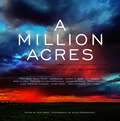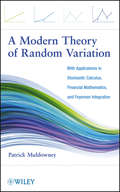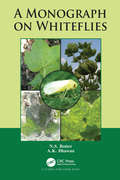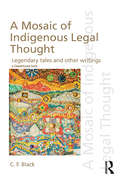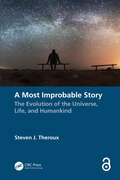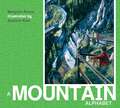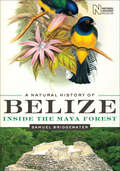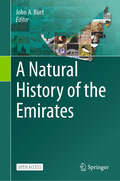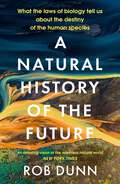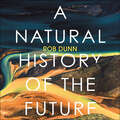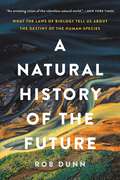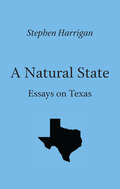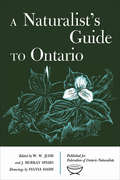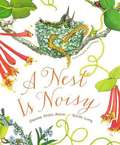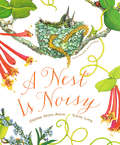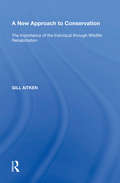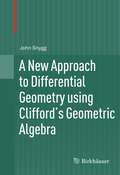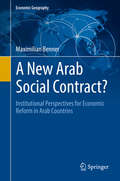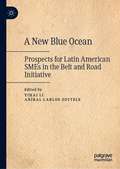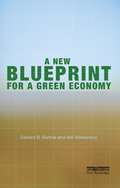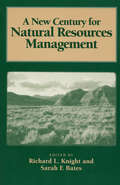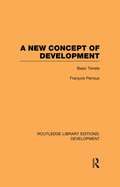- Table View
- List View
A Million Acres: Montana Writers Reflect on Land and Open Space
by James Grady Maile Meloy Keir Graff Rick Bass Jim Robbins Russell Rowland Carrie La Seur Jamie Harrison Joe Wilkins Christine Carbo Maxim Loskutoff Gwen Florio Janet Skeslien Charles Antonia Malchik Allen Morris Jones Caroline Patterson Eric Heidle Alexis Bonogofsky LeDoux Hansen Sterling HolyWhiteMountainMontana's stunning landscape shapes all who live here and all who visit. In twenty powerful pieces of writing—essays, memoirs, short stories—the state's finest contemporary writers explore the plains, rivers, and mountains of Big Sky Country. They show us how natural beauty and hardship are two sides of the same coin, and how sometimes the only way to cure heartache is to visit the great outdoors.From a hardscrabble upbringing to the pain of losing the family land, from death on a river to the awe of landing a big fish, from backcountry encounters with grizzly bears to an out-of-stater's happiness at making Montana her home, A Million Acres offers a wonderfully diverse range of experiences and perspectives. Framing these words are twenty-eight breathtaking photographs that render these open spaces in gorgeous color.Come to Montana: in words, in pictures, in person. And see what makes the Last Best Place worth saving.Contributors are:Rick BassMaile MeloyCarrie La SeurJoe WilkinsJim RobbinsGwen FlorioJamie HarrisonSterling HolyWhiteMountainJanet Skeslien CharlesMaxim LoskutoffChristine CarboJames Grady Alexis BonogofskyRussell RowlandCaroline PattersonKeir GraffEric HeidleLeDoux HansenAntonia MalchikAllen Morris Jones
A Modern Theory of Random Variation
by Patrick MuldowneyA ground-breaking and practical treatment of probability and stochastic processes A Modern Theory of Random Variation is a new and radical re-formulation of the mathematical underpinnings of subjects as diverse as investment, communication engineering, and quantum mechanics. Setting aside the classical theory of probability measure spaces, the book utilizes a mathematically rigorous version of the theory of random variation that bases itself exclusively on finitely additive probability distribution functions. In place of twentieth century Lebesgue integration and measure theory, the author uses the simpler concept of Riemann sums, and the non-absolute Riemann-type integration of Henstock. Readers are supplied with an accessible approach to standard elements of probability theory such as the central limmit theorem and Brownian motion as well as remarkable, new results on Feynman diagrams and stochastic integrals. Throughout the book, detailed numerical demonstrations accompany the discussions of abstract mathematical theory, from the simplest elements of the subject to the most complex. In addition, an array of numerical examples and vivid illustrations showcase how the presented methods and applications can be undertaken at various levels of complexity. A Modern Theory of Random Variation is a suitable book for courses on mathematical analysis, probability theory, and mathematical finance at the upper-undergraduate and graduate levels. The book is also an indispensible resource for researchers and practitioners who are seeking new concepts, techniques and methodologies in data analysis, numerical calculation, and financial asset valuation. Patrick Muldowney, PhD, served as lecturer at the Magee Business School of the UNiversity of Ulster for over twenty years. Dr. Muldowney has published extensively in his areas of research, including integration theory, financial mathematics, and random variation.
A Modified Baseline Incineration Process For Mustard Projectiles At Pueblo Chemical Depot
by National Research CouncilThe National Academies Press (NAP)--publisher for the National Academies--publishes more than 200 books a year offering the most authoritative views, definitive information, and groundbreaking recommendations on a wide range of topics in science, engineering, and health. Our books are unique in that they are authored by the nation's leading experts in every scientific field.
A Monograph on Whiteflies
by N.S. Butter A.K. DhawanIn all, 1550 species of whiteflies have been identified. The rapid spread of Bemisia tabaci has occurred throughout the globe and it is regarded as the most notorious species. It is a complex species known to contain many biotypes namely, New World (Biotype -A), B-biotype MEAM1 (Biotype-B or Bemisia argentifolii, and MED (Biotype-Q) depending upon the geographical location. The complete information on the bio-ecology of important species along with the feeding mechanism has been presented in this book. The use of modern techniques of identification has added more biotypes considering the variations in host range, species of endosymbionts, virus transmission efficiency, and resistance to pesticides. The resistance and resurgence due to pesticides has been discussed in the monograph. The information on economic thresholds for judicious use of pesticides or release of natural enemies against whiteflies has been quoted in this compilation The pest control methods, namely chemical, cultural measures, biocontrol agents, resistant varieties, and mechanical devices have been elaborated on. Based on the availability of information the integrated model has been suggested to contain the whitefly menace under different situations. Considering the key factors responsible for the outbreak of whiteflies, a sound system of IPM has been formulated. The book also contains the use of semiochemicals and biotechnological tools likely to gain momentum in the future.
A Mosaic of Indigenous Legal Thought: Legendary Tales and Other Writings
by C.F. BlackThis book offers an Indigenous supplement to the rich and growing area of visual legal scholarship. Organized around three narratives, each with an associated politico-poetic reading, the book addresses three major global issues: climate change, the trade in human body parts and bio-policing. Manifesting and engaging the traditional storytelling mode of classical Indigenous ontology, these narratives convey legal and political knowledge, not merely through logical argument, but rather through the feelings of law and the understanding of lawful behaviour produced by their rhythm. Through its own performativity, therefore, the book demonstrates how classical Indigenous legal traditions remain vital to the now pressing challenge of making peace with the earth.
A Most Improbable Story: The Evolution of the Universe, Life, and Humankind
by Steven J. TherouxThis book is a "Big History" of the evidence regarding how we came to be. It briefly explores philosophical thought and how our past might affect our future. The text summarizes different perspectives, including the strengths and weaknesses of each. The genesis of our planet is explored, especially the circumstances that must exist for complex life to arise. This brief journey highlights the history of life, the emergence of simple lifeforms, and the evolution of complex creatures, including humans. The book concludes with a discussion of why other humanoids went extinct while our species achieved dominance. The author speculates on potentialities awaiting humankind and our planet. The first "Big History" written from the perspective of a biologist Summarizes multiple perspectives of history Documents the unique conditions for the emergence of life Speculates on the future
A Mountain Alphabet (ABC Our Country)
by Margriet RuursMountains are an impressive sight anywhere in the world but those of the western mountain region of North America offer riches that are truly unique. This lavishly illustrated picture book presents snowcapped peaks, emerald lakes, tall pines and magnificent maples, and a range of birds and animals that will fill readers of all ages with wonder.The treasures and mysteries of nature are depicted in twenty-six full-color paintings, each with a line of alliterative text. Objects that begin with that letter of the alphabet are waiting to be discovered in each illustration. Complete with detailed information about each setting painted, this is a visually and mentally stimulating experience – from A to Z.
A National Strategy for Advancing Climate Modeling
by Division on Earth and Life Studies Board on Atmospheric Sciences and Climate Committee on a National Strategy for Advancing Climate ModelingAs climate change has pushed climate patterns outside of historic norms, the need for detailed projections is growing across all sectors, including agriculture, insurance, and emergency preparedness planning. A National Strategy for Advancing Climate Modeling emphasizes the needs for climate models to evolve substantially in order to deliver climate projections at the scale and level of detail desired by decision makers, this report finds. Despite much recent progress in developing reliable climate models, there are still efficiencies to be gained across the large and diverse U.S. climate modeling community. Evolving to a more unified climate modeling enterprise-in particular by developing a common software infrastructure shared by all climate researchers and holding an annual climate modeling forum-could help speed progress. Throughout this report, several recommendations and guidelines are outlined to accelerate progress in climate modeling. The U.S. supports several climate models, each conceptually similar but with components assembled with slightly different software and data output standards. If all U.S. climate models employed a single software system, it could simplify testing and migration to new computing hardware, and allow scientists to compare and interchange climate model components, such as land surface or ocean models. A National Strategy for Advancing Climate Modeling recommends an annual U.S. climate modeling forum be held to help bring the nation's diverse modeling communities together with the users of climate data. This would provide climate model data users with an opportunity to learn more about the strengths and limitations of models and provide input to modelers on their needs and provide a venue for discussions of priorities for the national modeling enterprise, and bring disparate climate science communities together to design common modeling experiments. In addition, A National Strategy for Advancing Climate Modeling explains that U.S. climate modelers will need to address an expanding breadth of scientific problems while striving to make predictions and projections more accurate. Progress toward this goal can be made through a combination of increasing model resolution, advances in observations, improved model physics, and more complete representations of the Earth system. To address the computing needs of the climate modeling community, the report suggests a two-pronged approach that involves the continued use and upgrading of existing climate-dedicated computing resources at modeling centers, together with research on how to effectively exploit the more complex computer hardware systems expected over the next 10 to 20 years.
A Natural History of Belize: Inside the Maya Forest (Corrie Herring Hooks Series)
by Samuel BridgewaterBelize’s Chiquibul Forest is one of the largest remaining expanses of tropical moist forest in Central America. It forms part of what is popularly known as the Maya Forest. Battered by hurricanes over millions of years, occupied by the Maya for thousands of years, and logged for hundreds of years, this ecosystem has demonstrated its remarkable ecological resilience through its continued existence into the twenty-first century. Despite its history of disturbance, or maybe in part because of it, the Maya Forest is ranked as an important regional biodiversity hot spot and provides some of the last regional habitats for endangered species such as the jaguar, the scarlet macaw, Baird’s tapir, and Morelet’s crocodile. A Natural History of Belize presents for the first time a detailed portrait of the habitats, biodiversity, and ecology of the Maya Forest, and Belize more broadly, in a format accessible to a popular audience. It is based in part on the research findings of scientists studying at Las Cuevas Research Station in the Chiquibul Forest. The book is unique in demystifying many of the big scientific debates related to rainforests. These include “Why are tropical forests so diverse?”; “How do flora and fauna evolve?”; and “How do species interact?” By focusing on the ecotourism paradise of Belize, this book illustrates how science has solved some of the riddles that once perplexed the likes of Charles Darwin, and also shows how it can assist us in managing our planet and forest resources wisely in the future.
A Natural History of the Emirates
by John A. BurtFor many people, thoughts of the United Arab Emirates conjure images of ultramodern skyscrapers and rolling sand dunes. However, the Emirates are a rich mosaic of ecosystems and habitats that support surprisingly diverse communities of organisms, and there is growing awareness of the importance of these previously underappreciated natural assets. A Natural History of the Emirates provides a comprehensive overview of the unusual environmental setting of this young nation, and surveys the major ecosystems and the marine and terrestrial organisms occurring across the nation. From freshwater streams in the hyperarid Hajar Mountains to the world’s most temperature-tolerant coral reefs, the UAE is home to an astounding variety of uniquely adapted organisms that are providing insights into climate change and how organisms cope with and respond to extreme environmental conditions. The book closes with a section on human interactions with this unique environment, and proposes initiatives to ensure the protection of these unique natural assets into the future. This is an open access book.
A Natural History of the Future: What the Laws of Biology Tell Us About the Destiny of the Human Species
by Rob DunnOver the past century, our species has made unprecedented technological innovations with which we have sought to control nature. From river levees to enormous one-crop fields, we continue to try to reshape nature for our purposes - so much so it seems we may be in danger of destroying it.In A Natural History of the Future, biologist Rob Dunn argues that nothing could be further from the truth: rather than asking whether nature will survive us, better to ask whether we will survive nature. Despite our best - or worst - efforts to control the biological world, life has its own rules, and no amount of human tampering can rewrite them. Elucidating several fundamental laws of ecology, evolution, and biogeography, Dunn shows why life cannot be stopped. We sequester our crops on monocultured fields, only to find new life emerging to attack them. We dump toxic waste only to find microbes to colonize it. And even in the London Tube, we have seen a new species of mosquito emerge to take advantage of an apparently inhospitable habitat. Life will not be repressed by our best-laid plans. Instead, Dunn shows us a vision of the biological future and the challenges the next generations could face.A Natural History of the Future sets a new standard for understanding the diversity of life and our future as a species.
A Natural History of the Future: What the Laws of Biology Tell Us About the Destiny of the Human Species
by Rob DunnA leading ecologist argues that if humankind is to survive on a fragile planet, we must understand and obey its iron laws.Over the past century, our species has made unprecedented technological innovations with which we have sought to control nature. From river levees to enormous one-crop fields, we continue to try to reshape nature for our purposes - so much so it seems we may be in danger of destroying it.In A Natural History of the Future, biologist Rob Dunn argues that nothing could be further from the truth: rather than asking whether nature will survive us, better to ask whether we will survive nature. Despite our best - or worst - efforts to control the biological world, life has its own rules, and no amount of human tampering can rewrite them. Elucidating several fundamental laws of ecology, evolution, and biogeography, Dunn shows why life cannot be stopped. We sequester our crops on monocultured fields, only to find new life emerging to attack them. We dump toxic waste only to find microbes to colonize it. And even in the London Tube, we have seen a new species of mosquito emerge to take advantage of an apparently inhospitable habitat. Life will not be repressed by our best-laid plans. Instead, Dunn shows us a vision of the biological future and the challenges the next generations could face.A Natural History of the Future sets a new standard for understanding the diversity of life and our future as a species.(P) 2022 Hachette Audio
A Natural History of the Future: What the Laws of Biology Tell Us about the Destiny of the Human Species
by Rob DunnA leading ecologist argues that if humankind is to survive on a fragile planet, we must understand and obey its iron lawsOur species has amassed unprecedented knowledge of nature, which we have tried to use to seize control of life and bend the planet to our will. In A Natural History of the Future, biologist Rob Dunn argues that such efforts are futile. We may see ourselves as life&’s overlords, but we are instead at its mercy. In the evolution of antibiotic resistance, the power of natural selection to create biodiversity, and even the surprising life of the London Underground, Dunn finds laws of life that no human activity can annul. When we create artificial islands of crops, dump toxic waste, or build communities, we provide new materials for old laws to shape. Life&’s future flourishing is not in question. Ours is.As ambitious as Edward Wilson&’s Sociobiology and as timely as Elizabeth Kolbert&’s The Sixth Extinction, A Natural History of the Future sets a new standard for understanding the diversity and destiny of life itself.
A Natural State: Essays on Texas
by Stephen Harrigan&“The personal essay at its best. What Edward Abbey did for the desert Southwest and what E. B. White did for Maine, Harrigan has done for Texas.&” —Houston Chronicle In this remarkable collection of essays, Stephen Harrigan explores, with an unfailing depth of feeling, the human longing to feel at home in the world of nature. In vivid and convincing prose, he evokes the landscape of his home territory, Texas, and his own reactions, sometimes droll, sometimes haunted, to the extraordinary power of place that Texas projects. &“Like our best nature writers, he tells us not only what&’s out there, but connects it to our everyday lives . . . A Natural State is recommended reading not just for Texans but for all who would explore their connections to the natural world.&” —The Washington Post &“While &‘luminous&’ is not a word that you would think of in connection with the Lone Star State, that&’s what these pieces are . . . They are filled with poetry, wit, and delightfully offbeat observations.&” —The San Diego Union-Tribune &“Harrigan defty weaves fact, historical perspective, and personal experience into a tightly interlaced evocative fabric . . . By the end of the book, he brings the vast Texas landscape within grasp of even the most skeptical reader.&” —The Denver Post &“Harrigan&’s observations are not those of an academically trained naturalist but rather the fresh outlook of a city-bred tourist rejoicing in the exhilaration of discovery.&” —Booklist &“Though several of the essays display a strong ecological bent, the author is never shrill. He is an accomplished prose stylist who combines accurate research with an unerring eye for detail. Highly recommended.&” —Science
A Naturalist's Guide to Ontario
by William Judd J. SpeirsTo the casual observer Ontario appears as an immense territory, stretching from west of the Great Lakes to the St. Lawrence, and from Hudson Bay to the southernmost tip of Lake Erie. The naturalist sees more than this vastness: he is aware of the province's great diversity in flora and fauna, and in geology and topography; he sees the province divided into zones and regions, each with its own special natural traits. Over the years some areas, and their special attractions, have become widely known to naturalists, amateur and professional. Others have not been so familiar. It has been difficult for visitors to and residents of Ontario to plan well-arranged trips which will include a number of them. A guide to Ontario, designed specifically for naturalists, has been needed, and this book will fill that need. The combination of scientific accuracy and up-to-date practical information will make it an invaluable part of the naturalist's field equipment. Along with maps and general descriptions of the flora, fauna, and geology of Ontario, this book contains over forty regional guides. Each guide lists, concisely and accurately, up-to-date information on how best to reach the regions that are of interest to the naturalist. There are also descriptions of the geology, plants, trees, birds, and mammals typical of each locale, along with information on rare or unique species, and information on local naturalists and nature clubs. Indexes of place names and names of species, and a list of reference manuals, complete the contents of this unique and valuable guide. It will be equally useful to those who pay occasional weekend visits to the countryside, and wish to know something about the rocks, plants and wildlife they encounter, and to the more serious student of natural history. The guide has been prepared by members of the Federation of Ontario Naturalists and other allied agencies in the hope that it will help encourage a wider appreciation of natural history in Ontario. Sylvia Hahn's attractive drawings indicate some of the great variety of plant and animal life to be found in the province.
A Nest Is Noisy
by Dianna Hutts Aston LongFrom the award-winning creators of An Egg Is Quiet, A Seed Is Sleepy, A Butterfly Is Patient, and A Rock Is Lively comes this gorgeous and informative look at the fascinating world of nests. From tiny bee hummingbird nests to orangutan nests high in the rainforest canopy, an incredible variety of nests are showcased here in all their splendor. Poetic in voice and elegant in design, this carefully researched book introduces children to a captivating array of nest facts and will spark the imaginations of children whether in a classroom reading circle or on a parent's lap.
A Nest Is Noisy
by Dianna Hutts AstonFrom the award-winning creators of An Egg Is Quiet, A Seed Is Sleepy, A Butterfly Is Patient, and A Rock Is Lively comes this gorgeous and informative look at the fascinating world of nests. From tiny bee hummingbird nests to orangutan nests high in the rainforest canopy, an incredible variety of nests are showcased here in all their splendor. Poetic in voice and elegant in design, this carefully researched book introduces children to a captivating array of nest facts and will spark the imaginations of children whether in a classroom reading circle or on a parent's lap. Plus, this is a fixed-format version of the book, which looks nearly identical to the print version.
A New Approach to Conservation: The Importance of the Individual through Wildlife Rehabilitation (Ashgate Studies In Environmental Policy And Practice Ser.)
by Gill AitkenConservationists assume a set of underlying values which guide their decision-making and action. The safeguarding or promotion of biodiversity, it is believed, is the means by which nature is best protected. This book examines - and challenges - these general conservation assumptions. While reinforcing the need to halt extinction and value biodiversity, it shows that biodiversity needs to be more clearly understood, perhaps being replaced by the notion of 'wildness'. It examines how biodiversity is a holistic term, and how individual species need to be assessed and their own contribution to 'wildness' has to be recognized. The book proposes a new way of conservation - one which makes more room for neglected, rather than endangered or rare species. It also asserts that 'wildness' is not incompatible with certain kinds of human intervention.
A New Approach to Differential Geometry using Clifford's Geometric Algebra
by John SnyggDifferential geometry is the study of the curvature and calculus of curves and surfaces. A New Approach to Differential Geometry using Clifford's Geometric Algebra simplifies the discussion to an accessible level of differential geometry by introducing Clifford algebra. This presentation is relevant because Clifford algebra is an effective tool for dealing with the rotations intrinsic to the study of curved space. Complete with chapter-by-chapter exercises, an overview of general relativity, and brief biographies of historical figures, this comprehensive textbook presents a valuable introduction to differential geometry. It will serve as a useful resource for upper-level undergraduates, beginning-level graduate students, and researchers in the algebra and physics communities.
A New Arab Social Contract?: Institutional Perspectives for Economic Reform in Arab Countries (Economic Geography)
by Maximilian BennerThis monograph offers a unique conceptual bridge between economic geography and Middle Eastern political economy. Arab economies are confronted with enormous structural difficulties such as high rates of youth unemployment in a challenging demographic context, exacerbated by intense spatial disparities. These structural problems demonstrate the breakdown of the "Arab social contract", a social arrangement centered on a strong role of the state in welfare and employment provision, for which regimes demanded acquiescence to authoritarian rule. The book argues that the Arab social contract can be understood in terms of regulation theories known in economic geography and sociology. It uses the approaches such as the regulation school, national systems of innovation, social systems of production, and varieties of capitalism to analyze the structural difficulties of Arab economies and current reform efforts. The basic assumption is that Arab economies are currently faced with a structural crisis. After the breakdown of the Arab social contract, there is a mismatch between the economic and institutional spheres of society. The challenge is for Arab societies to develop new forms of socio-institutional regulation. The book proposes ways towards such new modes of regulation by developing a framework for regulation specifically targeted towards Arab societies, and by applying it to the cases of Tunisia and Jordan.
A New Blue Ocean: Prospects for Latin American SMEs in the Belt and Road Initiative
by Yihai Li Aníbal Carlos ZotteleThis book explores the achievements and obstacles confronting China and major Latin American countries in developing small- and medium-sized enterprises (SMEs) in the context of new changes in “The Belt and Road” Initiative. In the first three chapters, the Chinese authors elaborate on the relationship between “The Belt and Road” Initiative and globalization, as well as strategies towards forming an increasingly close bond between China and Latin America. The book ends with chapters dedicated to analyzing the BRI conditions and effects on SMEs of Latin-American countries. These country specific chapters will show the specific opportunities and challenges the countries conditions, be they political, geological, etc. may have on the development of SMEs under the BRI. The book will be useful not only to industry leaders looking to better understand how they can potentially benefit from the BRI but also by the general public, as the book will explain what this new era of globalization, and more specifically the BRI, will mean for the world’s industries and society.
A New Blueprint for a Green Economy
by Edward B. Barbier Anil MarkandyaPublished in 1989, Blueprint for a Green Economy presented, for the first time, practical policy measures for 'greening' modern economies and putting them on a path to sustainable development. This new book, written by two of the Blueprint for a Green Economy authors, revisits and updates its main messages by asking, first, what has been achieved in the past twenty years, and second, what more needs to be done to generate a truly 'green economy' in the twenty-first century? Blueprint for a Green Economy had one over-arching theme. Making economies more sustainable requires urgent progress in three key policy areas: valuing the environment, accounting for the environment and incentives for environmental improvement. Today, with the threat of global warming, the decline in major ecosystems and their services, and fears over energy security, achieving these goals is even more vital. The current book first summarizes the main messages from Blueprint for a Green Economy and explains why, given rapid and widespread global environmental degradation, they are still relevant. The book then examines the progress since Blueprint for a Green Economy in implementing policies and other measures to improve environmental valuation, accounting and incentives. Although much has been accomplished, additional advances are still required to green economies successfully. The book highlights the new policies and approaches needed for economic management of today's environmental concerns. Over twenty years later, A New Blueprint for a Green Economy once again emphasizes practical policies for greening modern economies, and explains why such an economic roadmap to a greener future is essential, if modern economies are to develop successfully and sustainably.
A New Century for Natural Resources Management
by Robert Costanza Sarah F. Bates Vawter Parker Richard L. Knight Steward Pickett Peter BerckThis book explores the changes that are leading to a new century of natural resources management. It places the current situation in historical perspective, analyzes the forces that are propelling change, and describes and examines the specific changes in goals, policy, and practice that are transforming all aspects of natural resources management.The book is an important overview for wildlife biologists, foresters, and others working for public land agencies; professors and students of natural resources; and all those whose livelihood depends on the use of public natural resources.
A New Climate For Theology: God, The World, And Global Warming
by Sallie McFagueClimate change promises monumental changes to human and other planetary life in the next generations. Yet government, business, and individuals have been largely in denial of the possibility that global warming may put our species on the road to extinction. Further, says Sallie McFague, we have failed to see the real root of our behavioral troubles in an economic model that actually reflects distorted religious views of the person. At its heart, she maintains, global warming occurs because we lack an appropriate understanding of ourselves as inextricably bound to the planet and its systems. A New Climate for Theology not only traces the distorted notion of unlimited desire that fuels our market system; it also paints an alternative idea of what being human means and what a just and sustainable economy might mean. Convincing, specific, and wise, McFague argues for an alternative economic order and for our relational identity as part of an unfolding universe that expresses divine love and human freedom. It is a view that can inspire real change, an altered lifestyle, and a form of Christian discipleship and desire appropriate to who we really are. Table of Contents Preface Part One: The Science and its Significance for Theology Chapter 1: Climate Change: The Evidence and Consequences Chapter 2: Global Warming: A Theological Problem Part Two: Exploring God and the World within Climate Change Chapter 3: Who Are We? Ecological Anthropology Chapter 4: Who Is God? Creation and Providence Chapter 5: How Shall We Live? Christianity and Planetary Economics Part Three: Serving God and City Living within Climate Change Chapter 6: Why We Worship: Praise and Compassion as Intimations of Transcendence Chapter 7: Where We Live: Urban Ecotheology Part Four: Despair and Hope within Climate Change Chapter 8: Is a Different World Possible? Human Dignity and the Integrity of Creation in a Time of Global Warming Chapter 9: ?The Dearest Freshness Deep Down Things: The Holy Spirit and Climate Change Notes
A New Concept of Development: Basic Tenets (Routledge Library Editions: Development)
by François PerrouxFirst published in 1983, François Perroux’s A New Concept of Development analyses the major paradox of our era: the desire for progress and the mistrust of its consequences. The authors argues that the approach to the question of development may be the key to understanding both the present and what the future brings, representing a pattern which will seek to shape man’s potential to his designs. By analysing the ideas and theories propounded by the economic approach the author’s aim is to clarify both the meaning and direction of research in development. A scientific, oriented economy and efficient strategies should and must be the two components of one and the same momentum, required to go beyond the perilous paradox of our era.
